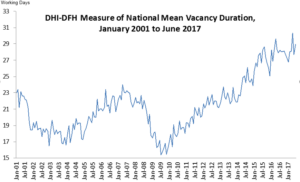Time-to-hire is one metric that remains to be a key performance indicator for hiring managers across industries. This is especially true because taking too long to fill an open position doesn’t just increase the cost per hire by manifolds, but with it also comes the risk of losing high-quality candidates who have a lot of opportunities at their disposal.
You’ll be surprised to know that the average time to hire was as high as 42 days in 2021 – it has been steadily increasing since 2010, when it took half as long to fill an open position.

Source: Dice
So then, what exactly can HR leaders do to mitigate the average time to hire at their company and retain high-performing candidates in the process of doing so?
Read on to find out!
Tips on How to Reduce Time to Hire
1) Establish a Structured Hiring Process
The first and foremost step to mitigating the overall time needed to fill an open position and scaling your team quickly is – having a structured hiring process in place.
When wanting to establish a structured hiring process, it helps to start with some brainstorming. You can also involve your recruiting team as you go about the research and ideation. This can be easily done by asking every member on the team to provide feedback about what they think can be done to make improvements to the recruiting funnel.
You can start by visualizing the candidate journey in detail – what are the steps involved, what does the process look like through their end, for how long does each stage last, what’s their first impression of the company going to be like, etc.
Having a well thought-over hiring process in place can help you in reducing the time to hire for every new resource by manifolds because that way, you’ll have a better idea about what you can do to optimize the candidate’s journey during each stage.
In one recent article, Adam Robinson, CEO and Co-Founder of Hireology, tells the spokesperson at Club Solutions Magazine why there is an increasing need for companies to think about ways to structure the hiring process:
“A structured hiring process is cost effective and will streamline how you find and qualify candidates. Plus, it can provide measurable, tangible results for your business by helping you avoid damage caused by bad hires.”
Some of the best practices you can follow to reduce the time to hire at your company are:
- map out the entire recruitment lifecycle at your company from both your as well as your ideal candidate’s perspective
- Try looking for tasks and processes that do not require much human intervention, and therefore, can be automated to speed up the recruitment process. Some examples of such tasks are: candidate information gathering by sending out forms, checking in with candidates who haven’t replied/written back, keeping candidates in the talent pipeline engaged with weekly informational email content, etc.
- Consider conducting group interviews instead of individual ones during the early stages of the hiring process to accelerate the process
- Segregate tasks on the basis of low and high priority, then address ones that need immediate attention right at the beginning
- Leverage state-of-the-art tech innovations such as predictive analytics, artificial intelligence, chatbot technology, etc. to identify past behavioral patterns of shortlisted candidates. This will quickly help eliminate people that aren’t the right fit for your company culture.
2) Build a Robust Talent Pipeline
A talent pipeline – or a database of candidates who are ready to fill a position at any given point in time – can be one of the most effective ways to reduce both the time and cost per hire at your company.
Building a robust talent pipeline ahead of time can be just the differentiator your company needs to get ahead of your counterparts and attract top talent.
When you have a number of previously qualified candidates on your existing database, you don’t need to wait to advertise your opening, attract candidates with it through marketing, and go about vetting the huge number of applications received. All you need to do is reach out to the candidates within your talent pipeline and inform them about the opening at your company.
A simple, tried-and-tested strategy you can use to build a robust talent pipeline that can be tapped into at any given point in time is:
- Identify the positions you hire for on a frequent basis
- Determine the specific requirements for those positions (eg: necessary skills, cultural fit, etc.)
- Try to identify the channels where the majority of candidates with these requirements could be looking for new opportunities (eg: conferences, industry events, job portals, etc.)
- Expand your reach and extend your marketing efforts to these channels. Think about ways you can attract candidates that come across as good fits
- Once you have a strategy in place to attract potential candidates, keep in touch with them and formulate an effective engagement strategy. You can either do this by leveraging content marketing and sharing valuable insights from within the niche, or you can engage them through personal messaging channels such as email and LinkedIn messaging.
Building a talent pipeline is also often considered the most effective way of sourcing candidates. But how do you do it efficiently when you deal with high volume recruiting?
The solution, again, lies with automating as many tasks as possible and letting technology help you!
3) Partner with a Recruiting Agency/ Leverage a Digital Hiring Platform
While there’s no solution in the market that can amalgamate all the disparate hiring systems and processes you follow at your organization to get them under one roof, there definitely are solutions that can take care of your complete hiring needs.
You guessed it right, we’re talking about outsourcing either the entire process or at least some part of it!
According to one recent report published by Grand View Research, the global recruitment process outsourcing (RPO) market size was valued at $5.48 billion in 2019 and it is only expected to grow at a compound annual growth rate of 18.5% for the next five years.
You can either look to leveraging:
- A digital hiring platform that helps plug any leaks in your existing recruiting toolkit and connects your existing tech stack to function as one, or
- A recruitment agency that takes care of all your hiring needs right from sourcing the right candidates to onboarding them.
These are both surefire and widely used methods for reducing time-to-hire by recruiting managers today.
While a digital hiring platform can help you create a hiring workflow and map the different tools you’ll be needing at every stage of the hiring cycle, a recruitment agency has years of experience in providing hiring help and knows how to leverage various tech innovations to speed up the recruiting process.
Recent research from the Korn Ferry Institute suggests that a certain recruitment agency’s RPO assessment considerably helped advance the hiring process for a lot of its clients. For one, data from 1,111 call center hires at a large security provider demonstrate two major advantages of this screening methodology:
- The RPO assessment helped increase screening efficiency by three to six times, depending on the job type.
- The RPO assessment saved on average three days of recruitment time per candidate.
To learn more about how to reduce time to hire for your company, feel free to reach out to us. We’ll be happy to help you with any hiring queries!
At BenchPoint, we have several years of experience in providing healthcare IT recruitment services. Our team of skilled and qualified healthcare IT recruitment professionals is equipped with a robust database of tech candidates from within different niches and is spread across different states.
